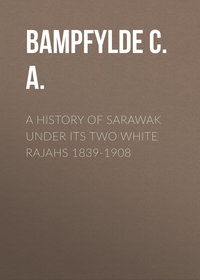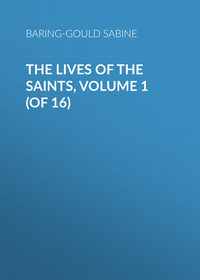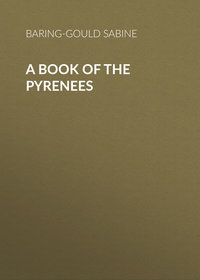 полная версия
полная версияA Book of the West. Volume I Devon
At the extremity of the landslip the visitor will see that there is still movement going on, but on a small scale – cracks are still forming and extending through the turf. It may be safely said that the landslip between the mouth of the Axe and Lyme Regis is one of the most interesting and picturesque scenes to be found in England.
There is a good deal more in the neighbourhood to be seen than the landslip at Rousdon and Pinhay. If the cliffs be explored to the west of the mouth of the Axe, they will be found to well repay the visit. The splendid crag of the White Cliff towers above the sea, showing the slanting beds of the cherty matter below the dazzling white of the chalk, and from their inclination giving to the whole cliff an appearance of lurching into the waves. Beyond this is Beer, a narrow cleft in the hills, in which are fishermen's cottages, many of them very picturesque, and above them rises a really excellently designed modern church.
A walk up the valley leads to the famous Beer quarries that have been worked for centuries. This splendid building-stone lies below the chalk with flints. There are eight beds, forming a thickness of twelve feet four inches, resting on a hard, white, calcareous rock five or six feet thick, which reposes in turn on sandstones. There is very little waste from these quarries, which are carried on underground; and all that is seen of them are the yawning portals in a face of white cliff. But a shout at the entrance will summon a workman, who will conduct the visitor through the labyrinth underground. The roof is sustained by large square pillars formed by portions of the workable beds left standing.
The stone is nearly white, and chiefly composed of carbonate of lime, with the addition of some argillaceous and silicious matter, and a few scattered particles of green silicate of iron. When first quarried this stone is somewhat soft, and is easily worked, but it rapidly hardens on exposure.
Opposite the new quarry are the mounds that mark the site of the old quarry, from which the stone was extracted for Exeter Cathedral. The subterranean passages there are now blocked, but during the time of the European war they were much used by smugglers, who abounded in Beer. The Memoirs of Jack Rattenbury, the most notorious of these, were published at Sidmouth in 1837, but are not of conspicuous interest. Beer Head has suffered from landslips, and is broken into spires of rock in consequence.
Books on the Landslip, and on Seaton: —
Conybeare and Dawson, Memoir and Views of Landslips on the Coast of East Devon, 1840. A very scarce work.
Hutchinson (P. O.), Guide to the Landslip near Axmouth. Sidmouth, 1840.
Davidson (J. B.), "Seaton before the Conquest," in Transactions of Devonshire Association, 1885.
Mumford (G. F.), Seaton, Beer, and Neighbourhood. Yeovil, n. d.
CHAPTER V.
EXETER
The river Exe – Roman roads – The Saxons in Devon and Exeter – Saxon and British Exeter – The Battle of Gavulford – S. Boniface at Exeter – His persecution of Celtic missionaries – S. Sidwell – Bishop's seat transferred to Exeter – S. Olave's Church – The Cathedral – Its merits and demerits – Ottery S. Mary – Excursions from Exeter – Fingle Bridge – Fulford – Ecclesiological excursions.
Exeter, the Isca Dumnoniorum of the Romans, was the Celtic Caer Wisc; that is to say, the caer or fortress on the Usk. The river-name has become Exe; it derives from the Celtic word which signifies water, and which we have in whiskey and Usquebaugh, i. e. fire-water.
The same word has become also Ock. Thus the Ockment River at Okehampton, a few miles down, becomes the Exe, at Exbourne; and a tributary of the Exe is the Oke, that flows into it near Bampton.
There have been but few Roman remains found in Exeter, and it can never have been an important settlement. Several Roman roads converge on it and radiate from it.
The great Fosseway, that ran from Lincoln through Leicester, reached it. It struck from Honiton, by Rockbeare and Clyst Honiton, and shows its antiquity by being the bounds of Broadclyst and Rockbeare, Sowton and Pinhoe parishes. It entered Exeter by Heavitree. Another Roman road from Lyme Regis enters Exeter by Wonford, where it joins the Fosseway. This road also proclaims its high antiquity by being a parish boundary. From Exeter an ancient road ran direct for Launceston: it is called in places the Old Street. It branched at Okehampton, and a road ran thence to Stratton, in Cornwall.
The Fosseway continued to Moreton Hampstead, and crossed Dartmoor, where it has served as the equator of that desolate region; all above it is esteemed the northern half, all below the southern half of Dartmoor. Further it has not been traced.
Another road, the Ridgeway, ran from Exeter to Totnes, and thence has been followed to Plympton Castle.
Whether these roads proceeded far in Cornwall cannot now be determined.
That these ways were possibly pre-Roman, but improved by the conquerors of the world, is probable. Hard by the roadside at Okehampton, in 1898, was found a hoard of the smallest Roman coins, all of the reign of Constantine the Great. It had probably formed the store of a beggar who "sat by the wayside begging." He hid it under a rock, and probably died without having removed it. About 200 coins were found, all dating from between A.D. 320 and 330.
The Saxons must have crept in without violent invasion, across the Axe, rather than through the gaps in the Black Down and Exmoor – for to the north, as already said, the vast morasses were a hindrance – and have established themselves without violent opposition by the riversides. Their manner of life was unlike that of the Britons. The latter clung to the open highlands, their Gwents as they called them, clear of trees, breezy downs; whereas the Saxons, accustomed to forests, made their stockades in the flat hams and ings by the rivers, in worths and on hangers.
Very probably the Dumnonii suffered their intrusion with reluctance, but they did not venture on forcible resistance, lest they should bring down on themselves the vengeance of Wessex.
When, however, the Saxons had established themselves in sufficient numbers, they had their headquarters in Exeter; but there they did not amalgamate with the natives. The Saxon town was quite apart from that occupied by the Britons, or West Welsh, as they called our Dumnonians. That part of Exeter which contains dedications to Celtic saints was the British town, as was also Heavitree,8 with its daughter churches of S. Sidwell and S. David; but the Saxons occupied where now stands the Cathedral; and each settlement was governed by its own laws. It was not till 823 that Egbert, by a decisive battle at Gavulford (Gafl a holdfast, and ffordd a road), established Saxon supremacy. He apparently drove the Devonshire Celts back along the Old Street, or Roman road, past Okehampton, till they made a stand at Coombow (Cwm-bod = the habitation in a combe). There the hills close in on the road on both sides, and the way branched to Lydford. Commanding both roads is Galford Down; there the Britons threw up formidable entrenchments, or, what is more probable, occupied an earlier camp that remains intact to the present day. Here they made a desperate stand, and were defeated; after which the king, Egbert, cast up a burgh beyond the old dun, which gives its second name to the place, Burleigh, or Burgh-legh. The last relics of the independence of the Dumnonian kingdom disappeared after Athelstan's visit in 926 and 928. A relic of this visit may be seen in Rougemont Castle, Exeter, where the Anglo-Saxon work – notably some herring-bone masonry, and windows rudely fashioned without arches – remains.
A Saxon school had been established in Exeter before A.D. 700, to which S. Boniface, or Wynfrith as he was then called, had been sent. He was a native of Crediton, then a Saxon stockaded settlement, and over the palisades, as a boy, he had looked with scorn and hatred at the native Britons occupying the country. When he was in Exeter he, in like manner, regarded the native Christians with loathing as heretics, because they did not observe Easter on the same day as himself, and perhaps with accentuated hate, because he knew that they had possessed Christian teachers and Christian privileges three centuries before his own people had received the Gospel. Perhaps also his German mind was offended at the freshness, vivacity, and maybe as well the fickleness of purpose of the native Celt. This early acquired aversion lasted through life, and when he went into Germany and settled at Mainz, to posture as an apostle, he was vexed to discover that Celtic missionaries had preceded him and had worked successfully among his Teutonic forefathers in their old homes. Thenceforth he attacked, insulted, and denounced them with implacable animosity, and did his utmost to upset their missions and supplannt them with his own. Virgilius, an Irishman, with a fellow Paddy, Sidonius, was at Salzburg, and Virgilius was bishop there. Boniface beat about for an excuse to get rid of them both. He found that the bishop, having discovered that one of his priests had been accustomed to baptise using a bad Latin formula, had acknowledged this man's baptisms as valid, for the will was present: the fault was due to ignorance of the Latin tongue. Boniface, hearing of this, laid hold of it with enthusiasm, and denounced Virgilius at Rome. Pope Boniface, however, took the side of the Irishman against his over-zealous henchman.
Mortified at this rebuff, Boniface lay in wait to find another excuse for ruining Virgilius. He ascertained presently that the Irishman taught that the earth was round, and that there was an antipodes to those living in Germany. Now the Irish schools were the most learned in Europe, and Irish saints had sailed far into the west over the Atlantic: they had formed their own opinions concerning the shape of the world. Boniface wrote to the Pope to denounce the doctrine of Virgilius as "perverse and unjust, uttered against God and his own soul."
This doctrine Pope Zacharias hastened to condemn as heretical.9 Virgilius had to go to Rome to justify his opinion before ignorant Latin ecclesiastics – with what results we do not know.
Athelstan came to Exeter in 926, and drove out the British inhabitants. He built towers and repaired the old Roman walls; he it was who founded the monastery of SS. Mary and Peter, afterwards to become the Cathedral; and, we are told, he gave to it relics of S. Sidwell. This was a local saint, of whom very little is known, save that she was the sister of Paul, who became abbot and bishop of Léon, in Brittany. She had two sisters, Wulvella and Jutwara, called also Jutwell and Eadware. Though the names seem Saxon, they are corruptions of Celtic originals. Wulvella became an abbess at Gulval, near Penzance, where she entertained her brother as he was on his way to Armorica. Sidwell is supposed to have been a martyr, possibly to Saxon brutality, but this is very uncertain, as her story has not been preserved. She has as her symbols a scythe and a well – "canting" symbols framed from her name. Her brother Paul founded a church that still retains his name, in the British portion of Exeter.
The bishop's seat had been at Crediton: the Saxon bishops did not like it. There were no walls there, and the Danes made piratical excursions. So Bishop Leofric induced Edward the Confessor to move the seat to Exeter, and this was done by Edward in person, in 1050.
In Fore Street is an odd misshapen little church, S. Olave's. This was endowed by Gytha, sister of Sweyn, the Danish king, and wife of Earl Godwin. She was the mother of Harold. She is said to have endowed it (1053) that prayer might be offered for the soul of her husband, and in honour of Olaf, King of Norway, who had fallen in battle in 1030. As S. Olaf fought against the Danes, and it was through the machinations of Canute that he came to his end, it is hard to see how a Danish lady should have felt any enthusiasm about Olaf, who was regarded as a saint and martyr by the national Norwegian party, which was bitterly opposed to the Danish. I suspect that the church already existed, and was dedicated to S. Gwynllyw of Gwent, who at Newport was also converted into Olave, by the English-speaking colonists. Both Gwynllyw and Olaf were kings, and it is noticeable that S. Olave's Church is in the British portion of Exeter. When William the Conqueror arrived before the city, Gytha, who was within the walls, escaped and took refuge in Flanders. William gave the church, with her endowments, to Battle Abbey. But I am not writing a history of Exeter. For those who desire to learn its story in full, I must refer them to the work of Mr. Freeman.
The Cathedral is disappointing, and that because it is built, not of the warm, red sandstone that abounds in the neighbourhood, and is very good building material, but of Beer stone, which is cold and grey. It has another defect: it is too low; but this was determined by the towers. When it was resolved to rebuild the Cathedral, it was decided to preserve the Norman towers, employing them as transepts. This settled the business. The church could not be made lofty; and on entering the western doors the visitor is at once disappointed. He feels a lack of breathing-space; the vaulting depresses him. The architectural details are not to be surpassed, but the whole effect is marred by the one mistake made at the outstart. One cannot wish that the towers had been removed, but one does regret that they were allowed to determine the height of nave and choir. The choir was begun by Bishop Quivil, in 1284, when also the great and incomparably beautiful windows were inserted in the towers. The nave was finished by Bishop Grandisson, in 1369, the year of his death.
Grandisson was a friend of the detestable John XXII., one of the Avignon Popes; and John appointed his intimate to Exeter in total disregard to the rights of the chapter to elect. He was consecrated at Avignon. Hitherto almost all the bishops had been local men.
Grandisson was a man very Romanly inclined, and appointed to a see that was redolent with Celtic reminiscences. He did not relish these. Whenever he had the chance of rededicating a church he endeavoured to substitute a patron from the Roman calendar in place of the British founder. He drew up a Legendarium, a book of Lessons on Saints' Feasts to be used in the Cathedral Church, and ignored nearly every saint whose name was not approved by admission into the Latin martyrology.
"The Church of Exeter is a remarkable case of one general design being carried out through more than a hundred years. It was fixed once for all what the new Saint Peter's should be like, and it grew up after one general pattern, but with a certain advance in detail as the work went westward. Bishop Grandison, when the church was about half built, said that when it was finished it would surpass in beauty all churches of its own kind in England and France. Whatever he meant by 'genus suum,' the prediction was safely risked. As far as outline and general effect goes, the Church of Exeter forms a class by itself." – Freeman.
A more remarkable church than the Cathedral of Exeter is that of Ottery S. Mary, also built by Grandisson. It is, of course, not by any means so large. It gave, perhaps, the original type to Exeter, for there also the towers have been employed as transepts, and was begun in the Early English style. But there a stateliness and an originality of effect are reached that Exeter cannot approach.
There the side aisles have but lancet windows, and a flood of light pours down through the very original clerestory lights. There is no east window. What the general effect must have been before the levels were wantonly altered at the "restoration" one can now hardly surmise. But the church, in spite of this and some odiously vulgar woodwork, is one of the most striking in England, and perhaps the boldest in originality of conception.
The Guildhall, in High Street, is a good example of Elizabethan architecture, in bad stone.
A beautiful excursion may be made from Exeter to Fingle Bridge,10 on the Teign, where the river winds between the hills densely wooded with coppice, that close in on each other like the fangs of a rat-trap. With this may be combined Shilstone cromlech, the sole perfect specimen of the kind remaining in the county, and once but a single member in a series of very remarkable monuments.
The Teign is frowned down on by several strongly fortified camps. Fingle should be seen when the hills are clothed in flowering heather, as though raspberry cream had been spilt over them. White heather may be picked there.
Fulford House is a quadrangle in a sad state of dilapidation; originally of Tudor architecture, but disfigured by bad alterations in the Prince Regent's days, when cockney Gothic was in vogue. In the house is a bad portrait of the "Royal Martyr," presented by Charles II., and one of "Red Ruin," a spendthrift Fulford. In the hall is some superb carved panelling, early Tudor.
Exeter may be made a centre for ecclesiological excursions of no ordinary interest. Dunchideock Church has a well-restored screen; but by far the richest carved oak rood-screen in the county is that of Kenton, where also the pulpit is of incomparable beauty. The carver employed thereon was a man of no common talent, and the work is one of brilliant execution. There is much difference in the carving in the county – some is common, mechanical; that in the Kenton screen and pulpit is of the very finest quality.
In the little church of S. Mary Steps, in Exeter, may be seen a portion of the screen removed from S. Mary Major when that monstrosity was erected. At Plymtree the screen bears on it contemporary portraits of Prince Arthur (son of Henry VII.) and Cardinal Morton. That of Bradninch has on it paintings of the Sibyls, the Doctors of the Church, and the Legend of S. Francis.
Pinhoe was the scene of a great battle with the Danes in 1001. They had come up the Exe, and burned Pinhoe, Broadclyst, and some of the neighbouring villages. Levies in Devon and Somerset met them, but were defeated with great slaughter. The church contains a fine coloured screen with the vaulting-ribs and gallery. The alms-box is curious: it represents a serving-man supporting himself with a stick in one hand, the other extended soliciting alms.
East Budleigh should be visited for its fine bench-ends, some very curious; one represents a cook roasting a goose; another a ship in full sail. Their date is 1534. There is a screen, but not of first quality.
Littleham, near Exmouth, has a good screen. Screens are the features of Devonshire churches: a church was built to contain one. Without it the proportions are faulty.
Books on Exeter: —
Freeman (E. A.), Historic Towns: Exeter. 1895.
Northy (T. J.), Popular History of Exeter. 1886.
Jenkins (A.), History of Exeter. 1841.
CHAPTER VI.
CREDITON
Red stone and red cob – Cob walls – The river Creedy – Birthplace of S. Boniface – See of Crediton – The Church – Kirton serge – Apple orchards and cider-making – Francémass – Apple the basis of many jams – Song of the apple trees – The picking of apples – "Griggles" – Saluting the apple trees – The apple-crusher – Pomage – The cider-press – Apple cheese – Cider-matching – Racking – Cider for rheumatism – A Cornish cider song – John Davy – Seats near Crediton – Elizabeth Buller and Frances Tuckfield – The Coplestone – The North Devon savages – Lapford – Churches round Crediton – Rev. S. Rowe.
A curious, sleepy place, the houses like the great church built of red sandstone, where not of the red clay or cob. But in the latter case the cob is whitewashed. No house can be conceived more warm and cosy than that built of cob, especially when thatched. It is warm in winter and cool in summer, and I have known labourers bitterly bewail their fate in being transferred from an old fifteenth or sixteenth century cob cottage into a newly-built stone edifice of the most approved style. As they said, it was like going out of warm life into a cold grave.
The art of building with cob is nearly extinct. Clay is kneaded up with straw by the feet, and then put on the rising walls that are enclosed in a framework of boards, but this latter is not always necessary as the clay is consistent enough to hold together, and all that is required is to shave it down as the wall rises in height. Such cob walls for garden fruit are incomparable. They retain the warmth of the sun and give it out through the night, and when protected on top by slates or thatch will last for centuries. But let their top be exposed, and they dissolve in the rain and flake away with the frost. They have, however, their compensating disadvantage – they harbour vermin.
Crediton takes its name from the Creedy river that flows near the town. The river is designated (Crwydr) from its straggling character, crumbling its banks away at every flood and changing its course. At a very early period the Saxons had succeeded in establishing a settlement here, a tun, and here Wynfrith, better known as S. Boniface, was born in 680. Willibald, a priest of Mainz who wrote his life, tells us that his father was a great householder, and of "eorl-kind," or noble birth. He loved his son Wynfrith above all his other children, and for a long time withheld his consent to his embracing the monastic life. During a serious illness, however, when death seemed near at hand, he relented, and Wynfrith was sent to school at Exeter. Thence he moved to Nutschelle, where he assumed the name of Boniface. At the age of thirty he was ordained. King Ina, of the West Saxons, honoured him with his confidence, and he might have risen to a high office in his native land, but other aspirations had taken possession of his soul. No stories were listened to at his time in the Anglo-Saxon monasteries with greater avidity than those connected with the adventurous mission of Archbishop Willibrord among the heathen Frisians, and Boniface longed to join the noble band beyond the sea. The abbot opposed his design, but Boniface was obstinate, and with three brethren left Nutschelle for London; there they took ship and landed in Frisia in 716. But the time was unpropitious, and he was forced to return to Nutschelle.
Next year he went to Rome, and then the Pope urged him to establish papal authority in Germany, which had been converted by Celtic missionaries, who had their own independent ways, that were not at all relished at Rome. Boniface, who hated the Celts and all their usages, eagerly undertook the task, and he went into Thuringia. He did a double work. He converted, or attempted to convert, the heathen, and he ripped up and undid what had been done independently by the Irish missionaries. In his old age he resumed his attempt to carry the Gospel into Frisia, and was there killed, A.D. 755.
A Saxon see was established at Crediton about 909, and was given three estates in Cornwall – Poulton, Lawhitton, and Callington. The Bishop was charged to visit the Cornish people year by year "to drive away their errors," for up to that time "they had resisted the truth with all their might, and had disobeyed the Apostolic decrees," that is to say, they clung to their ecclesiastical independence and some of their peculiar customs.
Crediton remained the seat of the Romano-Saxon bishops till 1046, when Leofric got the see moved to Exeter, where his skin would be safer behind walls than in exposed Crediton.
The church, dedicated to the Holy Cross, is a very stately building; the tower is transition Norman at the base. The rest is Perpendicular, and a fine effect is produced by the belt of shadow under the tower, with the illumined choir behind, which has large windows. The east window was mutilated at the "restoration." It was very original and delightful; it has been reduced to the same commonplace pattern as the west window.
Crediton was a great seat of the cloth trade, and many of those whose sumptuous monuments decorate the church owed their wealth to "Kirton serge." Westcote says that the "aptness and diligent industry of the inhabitants" (in this branch of manufacture) "did purchase it a pre-eminent name above all other towns, whereby grew this common proverb, 'as fine as Kirton spinning' (for we call it briefly Kirton), which spinning was very fine indeed, which to express the better to gain your belief, it is very true that 140 threads for woollen yarn spun in that town were drawn together through the eye of a taylor's needle, which needle and threads were for many years together to be seen in Watling Street, in London, in the shop of one Mr. Dunscombe, at 'The Sign of the Golden Bottle.'"









